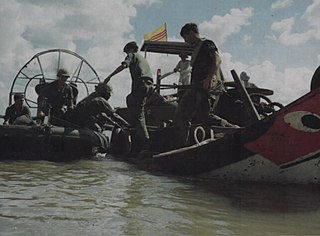
Tet 1969 refers to the attacks mounted by the People's Army of Vietnam (PAVN) and Viet Cong (VC) in February 1969 in South Vietnam during the Vietnam War, one year after the original Tet Offensive.

The Battle of Huế, also called the Siege of Huế, was a major military engagement in the Tết Offensive launched by North Vietnam and the Việt Cộng during the Vietnam War. After initially losing control of most of Huế and its surroundings, the combined South Vietnamese and American forces gradually recaptured the city over one month of intense fighting. The battle was one of the longest and bloodiest of the war, and the battle negatively affected American public perception of the war.

The 18th Division was an infantry division in the III Corps of the Army of the Republic of Vietnam (ARVN). The U.S. Military Assistance Command Vietnam considered the 18th as undisciplined and it was well known throughout the ARVN for its "cowboy" reputation. In 1975 the 18th was made famous for its tenacious defense of Xuân Lộc, the last major battle before the Fall of Saigon.

PHASE II of the Tet Offensive of 1968 was launched by the People's Army of Vietnam (PAVN) and Viet Cong (VC) against targets throughout South Vietnam, including Saigon from 29 April to 30 May 1968. The May Offensive was considered much bloodier than the initial phase of the Tet Offensive. US casualties across South Vietnam were 2,169 killed for the entire month of May making it the deadliest month of the entire Vietnam War for U.S. forces, while South Vietnamese losses were 2,054 killed. PAVN/VC losses exceeded 24,000 killed and over 2,000 captured. The May Offensive was a costly defeat for the PAVN/VC.

Operation Kentucky was a multi-battalion operation conducted by the United States Marine Corps in the area south of the DMZ in Quảng Trị Province. This was another operation to secure the Con Thien area from the People's Army of Vietnam (PAVN). The operation ran from 1 November 1967 until 28 February 1969.
Operation Shenandoah II was a security operation conducted during the Vietnam War by the U.S. 1st Infantry Division to secure and repair Highway 13, South Vietnam from 29 September to 19 November 1967.
Phase III of the Tet offensive of 1968 was launched by the People's Army of Vietnam (PAVN) and Viet Cong (VC) from 17 August to 27 September 1968. The offensive was divided into two waves of attacks from 17 to 31 August 1968 and from 11 to 27 September of that same year.
Operation Iron Mountain was a security operation during the Vietnam War in Quảng Ngãi Province, that took place from 28 February 1969 to 28 February 1971.
Operation Frederick Hill was a security operation during the Vietnam War in Quang Tin Province, that took place from 18 March 1969 to 28 February 1971.
Operation Geneva Park was a security operation during the Vietnam War in Quảng Ngãi Province, that took place from 18 March 1969 to 28 February 1971.
Operation Lamar Plain was a security operation during the Vietnam War in Quảng Tín Province, that took place from 15 May to 14 August 1969.
Operation Caroline Hill was a security operation during the Vietnam War conducted by the 196th Light Infantry Brigade, 23rd Infantry Division in Quảng Nam Province from 29 April to 1 July 1971. It was the 23rd Division’s last named operation of the war.
Operation Wolfe Mountain was a joint U.S. Army and Army of the Republic of Vietnam (ARVN) military operation during the Vietnam War to engage People's Army of Vietnam (PAVN) units in Quảng Trị Province from 22 July 1970 to 30 January 1971.
Operation Toan Thang III was a U.S. Army and Army of the Republic of Vietnam (ARVN) operation conducted between 17 February and 31 October 1969 in the Vietnam War. The operation was designed to keep pressure on Vietcong (VC) and People's Army of Vietnam (PAVN) forces in III Corps.

Operation Toan Thang II was a U.S. Army and Army of the Republic of Vietnam (ARVN) operation conducted between 1 June 1968 and 16 February 1969 in the Vietnam War. The operation was designed to keep pressure on Vietcong (VC) and People's Army of Vietnam (PAVN) forces in III Corps.
Operation Jeb Stuart III was a U.S. Army operation during the Vietnam War conducted by the 1st Cavalry Division that took place in Quảng Trị and Thừa Thiên Provinces of I Corps, South Vietnam from 17 May to 3 November 1968.
Operation Quyet Chien, was a United States Army and Army of the Republic of Vietnam (ARVN) security operation during the Vietnam War that took place from 3 August to 31 November 1968.
Operation Toan Thang IV was a U.S. Army and Army of the Republic of Vietnam (ARVN) operation conducted between 1 November 1969 and 1 May 1970 in the Vietnam War. The operation was designed to keep pressure on Vietcong (VC) and People's Army of Vietnam (PAVN) forces in III Corps.
Operation MacArthur was a United States Army military operation in the Central Highlands of South Vietnam from 12 October 1967 to 31 January 1969. The early phases of the operation encompassed the Battle of Dak To from 3 to 23 November 1967.
The DMZ Campaign (1969–71) was a military campaign by the United States Army, United States Marine Corps (USMC) and the Army of the Republic of Vietnam (ARVN) against the People’s Army of Vietnam (PAVN) along the Vietnamese Demilitarized Zone (DMZ) in northern Quảng Trị Province from 1969 to 1971 during the Vietnam War.





